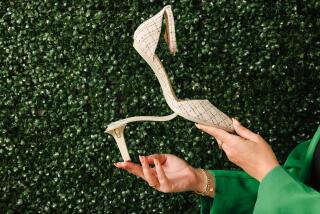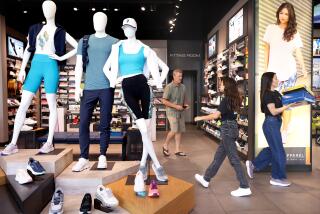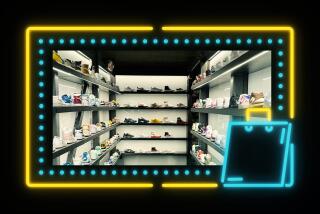Hot on Their Heels
- Share via
The sneaker business has been on loose footing for a year now, but athletic-shoe retailer Just for Feet Inc. keeps sprinting ahead with aggressive expansion plans--and Wall Street likes what it sees.
Indeed, stock in the Birmingham, Ala.-based chain hit a 52-week high this week of $28.94 in Nasdaq trading.
If you haven’t heard of Just for Feet, it’s because the company’s Southern California presence is currently limited to two stores: at the Ontario Mills outlet center in Ontario, and in the San Diego suburb of La Mesa.
But the retailer is counting on that changing. Just for Feet wants to get bigger, quickly, and makes no secret of its desire to one day supplant Foot Locker as the biggest U.S. chain of athletic-shoe stores. A key site of its ambition is Southern California.
“Once we start going into a territory, we don’t stop,” Just for Feet founder and Chairman Harold Ruttenberg said in a telephone interview, adding that his goal is to expand by 50 stores in California.
In the near future, Just for Feet plans to open more of its trademark “superstores” in the region. Typically built adjacent to shopping malls, the stores feature entertainment for shoppers and are up to 20,000 square feet in size, or about five times larger than mall stores run by Foot Locker and the No. 2 chain, Footaction USA.
Just for Feet will be a tenant at the Block at Orange, a giant $165-million, open-air retail and entertainment complex (formerly called CityMills) in Orange County that is scheduled to open this fall. In the San Diego area, the company plans stores in Vista and Mira Mesa later this summer.
The chain overall has 244 stores nationwide (including 59 franchised outlets), or 100 more than it had just a year ago. Besides erecting its own stores, Just for Feet also has been buying selected rivals--including smaller, mall stores--and last month it agreed to buy Sneaker Stadium Inc., which has 38 superstores of its own, mostly east of the Rockies.
Last year, though, Just for Feet’s blazing growth was one reason why the company stubbed its toe. As the sneaker business went soft--causing big problems for giants Nike Inc., Reebok International Ltd. and others--Just for Feet’s inventories bulged and its earnings growth came up short of 0expectations, said Marcia Aaron, analyst at BT Alex. Brown Inc. in San Francisco.
“They still made money, and profits were much better than the year before, but it wasn’t what we were looking for,” she said. Just for Feet’s profit for its fiscal year ended Jan. 31 shot up 34% from the prior year, to $21 million, on an 87% surge in sales to $479 million.
But Just for Feet’s “same-store sales”--those of stores open at least a year, and the retail industry’s key benchmark--rose 4.5% in fiscal 1997, a much smaller gain than in the prior four years.
“Like most participants in the industry, they did stumble a bit in 1997,” said Brent Rystrom, analyst at the investment firm Piper Jaffray Inc. in Minneapolis. “There were diminished expectations.”
This year Just for Feet is back on its, well, you know. Aaron said its same-store sales growth is holding steady around 4%--which “is what we would expect”--and at the same time the company has “really tightened up on their cost and inventory controls.”
Analysts also expect the company’s profit to jump 44% this year, to $1.01 per diluted share. Its stock--which went nearly straight up in the mid-1990s after the company’s initial public offering in 1994 and then backed off in 1996 and 1997--is again up a sizzling 94% so far this year. Nike, meanwhile, is up 14%, and Reebok is down 4%.
To be sure, Just for Feet is a long way from catching Foot Locker, a unit of Venator Group Inc. (the former Woolworth Corp.) that has nearly 3,000 outlets worldwide when its Lady Foot Locker and Kids Foot Locker stores are included. Just for Feet also has considerably fewer stores than the 550-outlet Footaction USA, which is owned by Footstar Inc.
But with its bigger stores, Just for Feet’s fiscal 1997 sales are fast closing in on Footaction’s, which totaled $608 million last year.
Just for Feet’s stores are designed to stand out in other ways. They often include basketball courts, games, videos and music, and there’s dozens of employees to help shoppers at each location. “It’s a different environment altogether,” Ruttenberg said. “We’re much more in the entertainment business.”
The stores also carry 4,000 to 5,000 styles of athletic shoes, versus a few hundred at mall stores. That wider selection helps insulate Just for Feet from consumers’ quickly changing tastes in the fashion part of the sneaker market.
“Our competitors are much more fashion-driven, so they carry only the latest and hottest [styles],” he said. “We carry them too, but they’re only a small part of our business.”
Ruttenberg, 55, started Just for Feet in 1977 with a single mall store in Birmingham. A native South African, he was running a small apparel business in Johannesburg in the mid-1970s when, sensing the increasing political turmoil swirling around apartheid, he moved his family to the United States.
With $20,000, he opened his first store but struggled at first. Unemployment and interest rates were sky high; consumer confidence was not. But after 10 years, his lone store was doing $4 million a year in sales.
He added a few stores but still had fewer than a dozen outlets when, in 1993, he decided to grow dramatically, and the next year he raised $20 million by taking the company public. Ruttenberg still owns about 20% of Just for Feet, a stake now worth $150 million.
* SECOND WIND: Nike and other retailers rebound from sluggish sales. D3
(BEGIN TEXT OF INFOBOX / INFOGRAPHIC)
On the Run
After dropping last year, Just for Feet shares are climbing up again. Monthly closes on Nasdaq and latest:
Thursday: $28.50
Source: Bloomberg News
More to Read
Inside the business of entertainment
The Wide Shot brings you news, analysis and insights on everything from streaming wars to production — and what it all means for the future.
You may occasionally receive promotional content from the Los Angeles Times.











